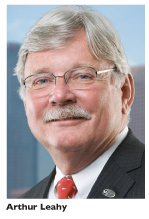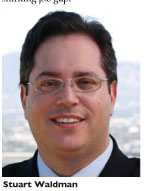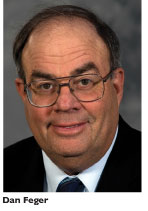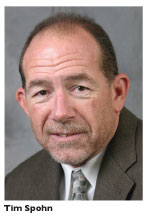By: Rebecca Mikkelsen and John Krikorian

What will 2012 bring for the business communities of the San Gabriel and San Fernando Valleys? Business Life surveyed the impact on our economic environment infrasture, social fields, including the November Presidential elects. We surveyed some of the region’s community and business leaders to learn what they view as the most pressing challenges and opportunities of the New Year. Here are their perspectives on factors ranging from employment levels and government spending to the impact of this year’s presidential election. Except for minor edition for clarity and brevity, the offerings that follow are the presentation of the writers.

Los Angeles County Metropolitan Transportation Authority
Arthur Leahy
CEO
When voters in Los Angeles County voted to tax themselves to fund much-needed transportation projects in November 2008, they set into motion a $40 billion funding mechanism to help fund dozens of critical transit and highway projects, which would in turn create a wide range of more than 210,000 jobs.
Today, Metro is embarking on one of the largest public works programs in the nation’s history that includes a dozen major transit projects and 15 highway projects throughout Los Angeles County.
The austere measures taken in the past two years – restructuring the bus and rail system, better managing our capital program and reducing our labor costs and cutting overhead -- have built a sound fiscal platform to deliver the many transit and highway projects called for in Measure R.
Metro’s ambitious $4.1 billion budget this fiscal year is a framework to maintain and enhance a truly sustainable transportation network.
Thirty-five percent of the budget will be devoted to the rail and highway capital programs which will create more than 500,000 jobs and stimulate the area’s economy. The new Expo light rail line to Culver City will be completed and the popular Metro Orange Line busway will be extended to Chatsworth. Construction of the Foothill Extension of the Metro Gold Line to Azusa is underway. We plan to break ground on the Crenshaw/LAX light rail line in 2012 along with other rail projects.
Metro, however, is not immune to the state and federal budget woes that could cut transportation funding.
The economy is still shaky and collective bargaining agreements with Metro unions are still being negotiated, but I am confident that the Metro Board of Directors can deal with these risks within the framework of this budget and still push forward with the progressive multimodal transportation agenda this county needs to prosper.

San Gabriel Valley Economic Partnership
Cynthia Kurtz
President and CEO
Even with unemployment in California just under 12 percent, every day I talk to employers who can’t find qualified candidates to fill their positions. Businesses are navigating a “job gap” - a disconnection between the skills available in the workforce and the specialized requirements of positions in high-growth fields. Businesses that require technically educated workers are recovering faster, adding to the demand for more employees.
It is easy to find studies that question the cost-benefit of a college degree. And it’s true that recent graduates are having a harder time finding employment than just two years ago. However, the bottom line is that education and training are more important today than ever before. The unemployment rate for workers with high school diplomas and no college degrees is twice as high as the rate for someone with Bachelor’s or higher degree.
It is more complicated than just having a degree or a certificate. Job candidates need to demonstrate they have the technical skills needed for a rapidly changing job market. Engineering, computer science and health care, especially nursing, physical therapy, pharmacy and medical technician, are all growth fields
The good news is that employers and institutions of higher education are paying attention. Businesses, especially those in high-tech and life sciences, are realizing the benefits of a strategic affiliation with a college or university that has research and development services.

Valley Industry and Commerce Association
Stuart Waldman
President
Schools want to train a workforce that is ready for tomorrow’s challenges. The San Gabriel and San Fernando Valleys are fortunate. We have great schools that are not only able but also eager to work with business.
I believe 2012 will be the beginning of even closer ties between business and higher education. We will see new alliances, changing curriculum, more opportunities for students, and a shirking job gap
There are several factors business leaders need to consider in the upcoming year. Significant changes can be expected to workers’ compensation in the State of California, with heated debate anticipated on both sides of the issue. The fact that 2012 is an election year will play a key role in economic recovery, likely causing it to lag, because elected officials will not want to make the drastic changes that are needed during campaign season.
In late 2011 or early 2012, we can expect to see a court decision on the fate of community redevelopment agencies (CRA). If the state is allowed to take funds from these crucial agencies it will be devastating for economic development, but a decision in the CRA’s favor would mean hundreds of millions of dollars invested in our local communities.
Also of local significance, the business tax reform conversations that are starting to gain support in Los Angeles will continue. VICA is hopeful that we will see meaningful business tax reform, with a key issue being the elimination of the gross receipts tax. A study commissioned by the city’s Business Tax Advisory Committee found that removing the tax would result in millions of dollars in economic activity and job growth for the city.

Foothill Workforce Investment Board
Phil Dunn
President
The Foothill Workforce Investment Board (FWIB) is one of forty-nine federally funded local workforce investment areas in California. We serve two clientele—job seekers and employers. We do not directly create jobs; rather, we facilitate economic development through workforce development. Our primary goal is to provide job seekers with the skills necessary to compete in the labor market and match them with the employers that have job openings. We anticipate a number of challenges and opportunities in 2012.
One of the primary challenges is the current political environment. The 2012 election will have a significant impact on the workforce development system. The Democrats have a greater commitment to government investment in workforce development. If the Democrats make gains in 2012, we can anticipate flat or increased spending in federal jobs programs. If the Republicans make gains, we can expect the reduction or elimination of Department of Labor (DOL) employment and training programs.
Regardless of who wins or loses, the political environment will present other challenges and opportunities. The Workforce Investment Act (WIA)—our primary funding source—is up for reauthorization. In addition, legislation has been passed at the State level requiring minimum funding levels for training.
A second challenge is the state of the economy. The unemployment rate at the national, state, and local levels remains high. Job growth is not at a level to absorb the growth in the labor force. The average time that the unemployed have been without work hit a record in September. The underemployment rate (unemployed, plus workers in part time jobs that want full time work, plus discouraged workers) is also at a high rate.
Because of these challenges, the FWIB must be nimble and make adjustments in this environment. We have to be creative to effectively serve our clientele. Our service strategy for 2012 is as follows:
• Implement program initiatives to service the hard to serve job seekers, such as foster youth, parolees, the long term unemployed, those with out of date job skill
• Promote alternatives to “getting a job” with a traditional employer, such as entrepreneurial programs, and apprenticeship training
• Leverage the resources of our partners (Employment Development Department, community colleges, unified school districts, chambers of commerce, unions, other WIBs)
• Green training, e.g. water technology, hybrid auto technology, and solar panel installation
• Business retention activities, including support for small business consulting, workshops, business showcases, job fairs, positive recruitments
With these strategies, we will weather the dual political and economic storms that confront us and prosper.

Bob Hope Airport
Dan Feger
Executive Director
The year 2012 will be challenging for the airlines, and Bob Hope Airport will address the challenge by operating a facility that meets the needs of the airlines and the travelling public within a sustainable cost structure. But the coming year will also present tremendous opportunity: the community at large will be able to participate jointly with the City of Burbank and the Airport Authority to shape the future of Bob Hope Airport.
The Airport and the City will start the year with an opinion-gathering program conducted by an independent professional research firm, and the results will be made public in the spring. The firm will use surveys and interviews to see what the community thinks about four key subjects: nighttime noise protection; the possibility of a replacement passenger terminal; ground transportation and traffic; and possible uses of the former Lockheed B-6 property. After that, everyone who wants to submit additional comments will be able to do so via an online survey. With broad input like this, we hope to identify proposals that can be achieved by consensus.
The Airport is also pursuing initiatives to relieve traffic and integrate air travel with present and future alternatives in public transit. This spring we hope to break ground on a Regional Intermodal Transportation Center next to the Bob Hope Airport Train Station that will bring air, rail, bus transit and rental cars together at a single location.
The Airport is also partnering with the Orangeline Development Authority and Metro to conduct a ground access study of possible improvements such as enhancement of bus service to the Airport and a new train station for the Antelope Valley Metrolink Line at Hollywood Way and San Fernando Road.
As we start 2012, we have the chance to move toward a unified vision of Bob Hope Airport for many years to come.

Metro Gold Line Foothill Extension Construction Authority
Habib Balian
CEO
The year 2012 is shaping up to be a monumental year for the Metro Gold Line Foothill Extension Construction Authority and the Foothill Extension light rail project from Pasadena to Azusa. In July 2011, the Construction Authority awarded a $486 million design-build contract to Kiewit Parsons Joint Venture to design and build the 11.5-mile, six-station Extension. The project, which has begun design and will be under construction in 2012, is on schedule to be completed in 2015. During construction, the project will generate nearly 7,000 jobs (more than 2,600 in the construction sector), more than $300 million in wages and salaries and just under $1 billion in business revenues for our region.
In 2012, the Authority will complete construction of the first element of the Pasadena to Azusa extension to move from design to construction – the I-210 Gold Line Bridge. The 584-linear foot bridge over the eastbound lanes of the I-210 Freeway between Baldwin and Santa Anita Avenues finalized design in 2011 and has been under construction since the summer. The $18.6 million bridge will provide the important connection between the existing Sierra Madre Villa Station in the median of the I-210 Freeway with the future Arcadia Station south of the freeway and is designed to become a gateway to the San Gabriel Valley.
Finally, in 2012 the Construction Authority will continue to focus our attention to future phases of the Foothill Extension. The next 12.6-mile extension from Azusa to Montclair began environmental review in 2011 and will complete that process in 2012, affording the Authority the ability to seek funding.
It is with great excitement that my team and I look toward the coming year and the progress to be made on this regionally important project. Happy New Year.

Alameda Corridor-East Construction Authority
Hon. Tim Spohn,
Chairman, Board of Directors
City of Industry Councilman
Public investment in transportation infrastructure is especially needed in Los Angeles County, where unemployment has lingered above the national average for several years and which has been designated the most congested metropolitan area in nation.
The good news is that the Alameda Corridor-East Construction Authority (ACE) will start construction of several grade separation projects (where the road goes over or under the railroad) in 2012, creating 11,000 jobs. Once these projects in the Cities of El Monte, San Gabriel, and Industry near Rowland Heights, are completed, crossing congestion chokepoints will be eliminated, safety and system reliability improved, emissions reduced and growth in our goods movement sector sustained.
Goods movement is crucial to Southern California’s economy, which serves as the nation’s leading trade gateway and inland corridor, handling more than 40% of all containerized imports. Nearly 60% of the trade arriving at the San Pedro Bay ports transits through the inland areas, imposing traffic and environmental burdens.
By next year, ACE will be under construction or have completed 14 grade separations. Existing and future conditions at the remaining rail-roadway crossings have been evaluated based on congestion and collision history and a list of feasible grade separation projects is expected to be adopted soon. These final projects can be completed if funding is made available.
In addition to drawing on existing state and local programs, ACE will seek funding opportunities through multi-year transportation legislation introduced in Congress. In the U.S. Senate, Senator Boxer is championing a robust bill (supported by ACE), which proposes several promising programs for freight projects, including grade separations. With the support of our federal, state and local representatives, ACE will continue to make progress and complete its program of goods movement improvements for the benefit of our region and our nation.
For more information please visit www.theaceproject.org or call (888) ACE-1426.

Glendale Adventist Medical Center
Kevin Roberts
President and CEO
Healthcare reform is no doubt changing the landscape of healthcare. While change is not easy, it is important, especially as the health industry adjusts to the changing needs and expectations of those we serve and together we work towards long term sustainability.
As we enter 2012, I am proud to work with medical teams to introduce some of the many benefits of current health care reform laws into our community. For patients, this means that the vision of safe and secure electronic medical records is a reality to be enjoyed today. It means that hospitals and physicians are true medical partners in accepting the responsibility of the health of our community.
The heritage of the Seventh-day Adventist Church has long focused on preventative wellness measures, as evident in the mission of Glendale Adventist Medical Center, “To share God’s love with our community by promoting healing and wellness for the whole person.” Our mission has remained virtually unchanged in the more than 100 years since opening our doors. But, we have watched as other leaders in health care, especially those promoting health care reform have aligned with a vision more similar to ours; one focused on wellness and the responsibility of health care providers to care for the whole person.
Our community deserves to be treated with the best-trained specialists using the best possible equipment. One need only think for a moment of how far health care has come in the last five years to know that it is imperative for a hospital like Glendale Adventist Medical Center to manage growth by continually reinvesting

City of Burbank
Mike Flad
City Manager
The close of 2011 marks a milestone for the City of Burbank celebrating its centennial year. Burbank has much to be proud of and much more to look forward to in the future. The Centennial Celebration held on July 8th highlighted the past, present and future of Burbank. With its humble beginnings in the agriculture industry to aerospace and now entertainment, Burbank has proven to be resilient, changing to the growing needs of the industry and the workforce. It is with this same philosophy that Burbank has remained a strong and economically thriving city.
With one of the lowest vacancy rates in the tri-city region and the county, Burbank has maintained a steady flow of new businesses while keeping the existing business community intact. Some new businesses include; 24 Hour Fitness, Racer’s Edge Indoor Karting, Olive & Thyme Restaurant, Another Broken Egg Café, and Panera Bread. Many new companies will be opening their doors in Burbank in 2012, such as KCET, DC Comics, Gap Factory Store, Bigfoot Entertainment, and others creating an estimated 850 new jobs.
With the launch of our newly formed Tourism Business Improvement District (T-BID), spearheaded by the hospitality industry in Burbank, we continue to put Burbank on the map. This time, not only as the Media Capital of the World, but also as a destination city for Southern California. The T-BID will provide for an aggressive tourism campaign with a visitor guide featuring Burbank as the ultimate place to stay and play while venturing out into the rest of Southern California.
The Citywide Marketing Campaign for 2012 will focus on promoting Burbank as a competitive regional and national hub with targeted emphasis on new or expanding green technology and entrepreneurial companies.
With our competitive business incentives such as no gross sales receipt tax and no city income tax, plus a one-stop permitting center, Burbank continues to provide the right tools and resources for businesses. Another key component in attracting and retaining business in Burbank is our successful ONE (Optical Network Enterprise) Burbank service. ONE Burbank expands on Burbank Water and Power’s existing fiber infrastructure to provide high-speed bandwidth services for local Burbank businesses.
Unemployment rates continue to be a key indicator of the overall health of the economy. For Burbank, unemployment percentages are lower than those of Los Angeles County and the State of California. As the small businesses community continues to adapt to the changes of the economy, Burbank continues to provide the tools and resources necessary to keep small businesses thriving. With new curriculum added to our Team Business Program and the newly revamped Shop Burbank Program, the business community can take advantage of these free or minimal cost resources to help take their business to the next level.
As we move into 2012 we were fortunate to reminisce and celebrate our past and we are ready to embrace our future

City of Pasadena
Michael Beck
City Manager
Like all other state and local governments, the city of Pasadena is feeling the effects of the economy while weathering the global recession.
Thanks to the leadership of elected officials and executives as well as the spirit of cooperation and shared sacrifice exemplified by our employees, the city continues to deliver outstanding municipal services to the entire community. Pasadena will have a bright future and move forward with confidence and optimism.
We will continue to work smarter and more efficiently with an even greater focus on our most important opportunities, one of which is economic development. It is an essential tool that provides tangible benefits, building this community’s brain trust and increasing employment prospects for our citizenry.
We are expanding partnerships to facilitate more local jobs and leverage our community’s significant strengths. Pasadena’s institutions continue to attract a significant amount of research dollars. Caltech’s synthetic photosynthesis project and several other research teams are exploring new opportunities for green energy and exciting products. Financial, engineering, technology, education and design sectors help support an exciting retail and service base that adds to the quality of life. Entertainment, tourism, leisure and convention business is robust and provides an added consumer base. Anchored by the annual Rose Parade and Rose Bowl Game, these activities attract shoppers in the form of conventioneers and visitors. With expanding culinary options adding to an already attractive mix of dining experiences, Pasadena remains in the forefront of visitors’ and consumers’ minds for entertainment and shopping.
All this is being accomplished by continually growing an economic base that will generate sufficient revenues to sustain and enhance public services and infrastructure used by businesses, institutions, residents and visitors.
Pasadena has all the advantages necessary for business to flourish. I invite everyone to discover the opportunities in Pasadena by visiting www.cityofpasadena.net/economicdevelopment or calling (626) 744-4660.
Editors Note: Business Life welcomes Scott Ochoa to his new position as City Manager of Glendale, which he began in January. Mr. Ochoa, former City Manager of Monrovia, was unable to participate in this article at the time of publication.

|